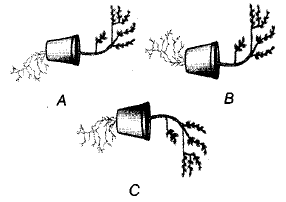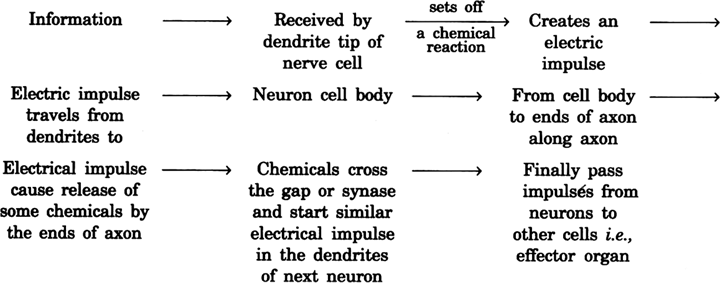Control and Coordination - Test Papers
CBSE Test Paper-01
Chapter 07 Science Control and Coordination
- Which Plant hormone essential for cell division ? (1)
- ethylene
- gibberellins
- auxin
- cytokinin
- The neurons that carry nerve impulse from spinal cord to effectors are Known as (1)
- Motor neurons
- spinal neurons
- Inteneurons
- Sensory neurons
- Auxins are (1)
- Vitamins
- Enzymes
- Proteins
- Hormones
- Match the following with correct response. (1)
(1) Central nervous system (A) Brain (2) Peripheral nervous system (B) Sympathetic nervous system (3) Autonomic nervous system (C) Cranial and spinal nerves (4) Reflex action (D) Reflec arc - 1-C, 2-B, 3-D, 4-A
- 1-D, 2-A, 3-C, 4-B
- 1-B, 2-D, 3-A, 4-C
- 1-A, 2-C, 3-B, 4-D
- The substance that cause fall of mature leave and fruits from plants is due to: (1)
- auxin
- gibberllin
- cytokinin
- ABA
Name the membranes covering the brain and spinal cord. (1)
Name the largest cell present in the human body. (1)
Name the gland which is called 'Master gland'. (1)
Name the other name of hormones. (1)
Sameer was studying in his room. Suddenly he smells something burning and sees smoke in the room. He rushes out of the room immediately. Was Sameer's action voluntary or involuntary? Why? (3)
In figure A, B and C, which appears more accurate and why? (3)

Give a few functions of gibberellins along with auxin. (3)
- Define neurons. Identify the parts of a neuron at which: (3)
- information is all together collected.
- impulses are converted to chemical signal for further transmission.
Compare nervous and hormonal mechanism for control. (5)
With the help of labelled diagram explain the general scheme to illustrate how nervous impulses travel in the body? (5)
CBSE Test Paper-01
Chapter 07 Science Control and Coordination
Answers
- cytokinin
Explanation: Cytokinin hormone is responsible for cell division that help in growth of plants. It is found in sites of active cell division in plants for example: Roots tips,seeds,fruits and leaves.
- cytokinin
- Motor neurons
Explanation: Motor neurons are responsible for carrying information from spinal chord to effector. The cell bodies of motor neurons are inside the Central Nervous System.
- Motor neurons
- Hormones
Explanation: Auxin is a plant hormone produced in the stem tip that promotes cell elongation. Auxin moves to the darker side of the plant, causing the cells there to grow larger than corresponding cells on the lighter side of the plant.
- Hormones
- 1-A, 2-C, 3-B, 4-D
Explanation: The central nervous system (CNS) is made up of the brain, the spinal cord, and the optic nerves; the nervous system outside the brain and spinal cord; the part of the nervous system responsible for control of the bodily functions not consciously directed, such as breathing, the heartbeat, and digestive processes; Reflax action is an involuntary and nearly instantaneous movement in response to a stimulus.It is made possible by neural pathways called reflax arc.
- 1-A, 2-C, 3-B, 4-D
- ABA
Explanation: Absesic acid (ABA) hormone cause to fall of mature leaves and fruits from plants.
- ABA
Meninges are membranes that cover and protect the brain and spinal cord.
Neuron or nerve cell.
Pituitary gland is called the master gland because it produces hormones that control other glands and many body functions including growth.
- Chemical coordinators (messengers)
Sameer’s action was voluntary because rushing out of the room was under his conscious control. The smoke and smell were perceived by the receptors in the sense organs and signals are sent to the brain. The brain, then sent signals to the effector organs, i.e., the muscles, to move out of the room to protect tthemselves.
This movement of plant part in response to gravity is called geotropic movement and the phenomenon involved is called geotropism. Here, Figure (A) is more accurate to show geotropism. The roots of a plant always grow downward in response to the gravity (called negative geotropism) to make sure they find soil and water. On the other hand, the stem always grows up, i.e., away from gravity pull (called positive geotropism) to make sure it will get light. Both these conditions are shown in figure A.
The gibberellins are weakly acidic phytohormones which help in longitudinal growth of the stem.
- The two collectively control fruit growth and development.
- Control of flowering in long day plants.
- Sex expression in certain species as spraying with gibberellins cause some cucurbits to produce female flowers.
- Gibberellins cause parthenocarpy in apple and pear.
The structural and functional units of nervous system are called neurons. It means the units which makes up the nervous system are called neurons. These are specialized units for acceptance and transmission of impulses to and fro between the brain and other body parts.
- End of dendrite tip of nerve cell.
- Dendrite cell body axon to its ends.
Nervous System Hormonal System Made of neuron Made of Hormone Messages transmitted in the form of electrical impulses Message transmitted in the form of chemicals called hormones. Messages transmitted along nerve fibres. Messages transmitted through blood stream. Messages travel very quickly. Messages travel very slowly. Effect of message usually lasts for a very short while Effect of message usually lasts longer Sense organs are receptors as nerve cells located in them receive information. Glands are effectors which secrete hormones when the brain commands. 
The information from the environment is detected by receptors and passed on to the dendrite of the sensory neuron, from where the electrical signals are passed on to the cyton then to axon and finally to the presynaptic knob which releases neurotransmitters which goes to the synaptic cleft and generates an electric response on to the dendrite of the next neuron and ultimately to brain (or spinal cord). The response from brain (or spinal cord) is similarly passed on to the effector, that undergoes the desired response.
